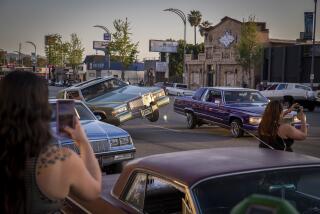Review: Three’s company, or a crowd? Polaris and Vanderhall three-wheeled autocycles ride a growing trend
- Share via
Three-wheeled “autocycles,” made by Polaris, Can-Am, Elio, Arcimoto, Vanderhall and others, are gaining in popularity.
Half car, half motorcycle, the three-wheelers are a motorsports tweener. In some jurisdictions they are regulated like automobiles. In others, they are considered motorcycles.
They’re prized by some because they are more stable than two-wheeled motorcycles, and by others because they are more fun than four-wheeled automobiles.
They may also be popular, in part, because they are such head-turners. Like the Ural sidecar motorcycles we reviewed a while back, or the exotic three-wheelers made by England’s Morgan Motor Co., they always draw a crowd of looky-loos who ask, “What is that thing?”
The Polaris Slingshot is one of the bestselling examples of the three-wheeled models, and on Southern California roads one of the most visible.
An open-air roadster, the Slingshot is a “reverse trike,” with one broad drive wheel in back and two pivoting nondrive wheels upfront.
It features two seats, side by side, and a steering wheel — the opposite of its most popular rival, the Can-Am Spyder, which has two seats, front to back, and steers using something more like a handlebar.
The Slingshot is driven by a General Motors Ecotec engine, a 2.4-liter, four-cylinder engine that puts out 173 horsepower and 166 pound-feet of torque.
Power is delivered to the rear wheel via a carbon fiber belt, through a five-speed manual gearbox. (An automatic gearbox is also available.)
Because it weighs 1,749 pounds fully fueled, and sits low to the ground, and has nothing but a fiber shell between driver and engine, the Slingshot accelerates quickly, and loudly, and produces a visceral driving experience.
As I was leaving the garage on my first drive, a pedestrian asked me, “Is it smooth?”
It’s not. Like the opposite of the old R&B song, it is built for speed, not for comfort. With minimal operator options — no drive modes, no suspension modes, though this trim line comes standard with a Bilstein adjustable suspension system — this is a go-fast go-kart designed for having fun.
Behind the wheel, on the stiff suspension, you feel every wrinkle in the road. An unseen pothole may require a visit to the chiropractor. If there’s coffee in that cup holder, make sure the lid is on tight or you’ll wind up with latte in your lap.
Polaris makes a variety of Slingshots. This SLR LE model I drove is about the top of the line. While the entry-level Slingshot S starts at $19,999, plus fees, the SLR LE retails for $30,999.
The higher trims come standard with the Polaris “Ride Command,” which brings automotive-level navigation, rear-camera and audio technology into the three-wheeler scene.
But that’s the only amenity. The Slingshot doesn’t have a heater or an air conditioner. The short windshield isn’t adjustable. The seats aren’t adjustable, either, and taller drivers may not like the knee-bend.
Because they are classified as autocycles in most jurisdictions, the Slingshots (and most other three-wheelers) are not required to have air bags or meet safety or fuel economy standards set for automobiles.
But because the Slingshots have steering wheels, and side-by-side seats, and a rudimentary roll bar, they are not quite motorcycles, either. So, in many states operators are not required to have a motorcycle endorsement on their driver’s licenses, and in most jurisdictions the driver is not required to wear a helmet.
Polaris recommends its users wear helmets — though the Slingshot, with only a small locking glove box, has no secure storage space for them — and I did. At 60 miles per hour, on the freeway, 5 inches off the ground, it seemed sensible.
If the Slingshot resembles the Batmobile, the Vanderhall Venice looks like something Barney Oldfield would have raced in the 1920s.
Sleek and stylish, this reverse trike also sits low to the ground and is designed to create a very engaged driving experience.
Like the Slingshot, it features step-in seating and a side-by-side cockpit for two. It’s fitted with seat belts and a steering wheel, which helps it qualify for autocycle status.
But because the Vanderhall sports a DOT-approved laminated windshield, and has deployable roll bars, the Vanderhall is even less of a motorcycle. That means, according to its manufacturer, that in many jurisdictions no motorcycle endorsement is required, and that in California the use of a helmet is entirely optional.
It’s somewhat more sophisticated than the Slingshot, and a lot more self-conscious in its design. Beautiful throughout, from the wood grain steering wheel to the retro-styled dashboard dials, it boasts splendid fit and finish. Every part feels lovingly handcrafted.
The Venice (and its fancier sibling, the Laguna) is powered by a 1.4-liter, four-cylinder, turbocharged engine that Vanderhall says makes 200 horsepower and 200 pound-feet of torque.
With those specs, and at 1,550 pounds, the Venice is lighter and more powerful than the Slingshot. Using the optional “auto-manual” bump shifter to move through the six gears (the company does not offer a true manual transmission on any of its vehicles) makes the most of the little car’s power.
Around town and on curvy canyon roads, the Venice is zippy and exhilarating. It corners well and, like the Slingshot, can be made to slide and drift through the turns.
I loved the Venice’s exhaust pipes, and the hissing sound of the turbo, which combined with the happy rumble of the engine made the morning commute a musical comedy.
It offers more comfortable ergonomics than the Slingshot — more seat adjustment, seat heating and a rudimentary “heater” that brings warm air from the engine compartment into the cabin, with air conditioning available only on the more expensive Laguna — but it’s just as stiff a ride.
On the freeway, it’s just as thrilling, or terrifying. The speedometer goes all the way to 160 mph, and I’ve seen the top speed on the Venice listed as 140 mph.
Both those numbers seem unlikely, and unwise, and I attempted nothing close to that speed. Without a helmet, 60 mph on the 210 Freeway made for pleasantly dramatic motoring.
Anything greater than that exposed the limitations of the elegant windscreen, which is cute to look at but doesn’t actually screen the wind very well. If you’re wearing a hat, you may want to attach a chin strap, or risk losing it. (Or wear a helmet, but the Venice, like the Slingshot, doesn’t offer any place to securely store one.)
The Venice would be perfect for tooling around Venice. I enjoyed it most at mid-range speeds, the speakers connected via Bluetooth to my Spotify account, with Gerry Mulligan providing the soundtrack.
But enjoyable as it was, I kept noticing some of the vehicle’s form-over-function defects.
That old-school wooden steering wheel is really cute, but it’s hard on the hands. That windscreen has such a delicate line to it, but the outer edges of the curves distort the view badly. And its low profile leaves no room for sun visors or windshield wipers. And those delicate mirrors? Better for looking at than for seeing with.
It seems unlikely that anyone will be drawn to the Venice or the Slingshot for its commuter qualities. Limited by the absence of air conditioning, weather protection or any kind of sound deadening materials, neither one would make a sensible daily driver.
But either one would be an amusing choice for someone aspiring to occupy that interesting space between motorcycle and motorcar, especially someone who doesn’t want to buy a bike or add a convertible to the family fleet, or someone who wants a tremendous amount of attention at every stop light and a long conversation at every gas stop.
How to choose between the two? It’s a matter of personal style. Are you more Batman or Barney Oldfield?
2018 Polaris Slingshot SLR LE
Times’ take: A baby Batmobile for the street
Highs: Go-fast engine in a go-kart frame
Lows: One size won’t fit all
Vehicle type: Two-passenger reverse trike autocycle
Base price: $30,999
Price as tested: $30,999
Powertrain: 2.4-liter, four cylinder, Ecotec gasoline engine
Transmission: 5-speed manual; belt drive
Horsepower: 173
Torque: 166 pound-feet
EPA fuel economy rating: N/A
2018 Vanderhall Venice
Times’ take: Stylish head-turning car toy
Highs: Delicious engine, delightful styling
Lows: Visibility issues with windshield, mirrors and more
Vehicle type: Two-passenger reverse trike autocycle
Base price: $29,950
Price as tested: $33,708
Powertrain: 1.4-liter, four cylinder, turbocharged gasoline engine
Transmission: 6-speed automatic
Horsepower: 200
Torque: 200 pound-feet
EPA fuel economy rating: N/A







